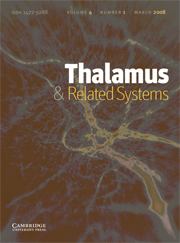Crossref Citations
This article has been cited by the following publications. This list is generated based on data provided by
Crossref.
Stern, Jair
Jeanmonod, Daniel
and
Sarnthein, Johannes
2006.
Persistent EEG overactivation in the cortical pain matrix of neurogenic pain patients.
NeuroImage,
Vol. 31,
Issue. 2,
p.
721.
Llinás, Rodolfo R.
and
Steriade, Mircea
2006.
Bursting of Thalamic Neurons and States of Vigilance.
Journal of Neurophysiology,
Vol. 95,
Issue. 6,
p.
3297.
Alexander, G.M.
Carden, W.B.
Mu, J.
Kurukulasuriya, N.C.
McCool, B.A.
Nordskog, B.K.
Friedman, D.P.
Daunais, J.B.
Grant, K.A.
and
Godwin, D.W.
2006.
The native T-type calcium current in relay neurons of the primate thalamus.
Neuroscience,
Vol. 141,
Issue. 1,
p.
453.
Moazami-Goudarzi, Morteza
Sarnthein, Johannes
Michels, Lars
Moukhtieva, Renata
and
Jeanmonod, Daniel
2008.
Enhanced frontal low and high frequency power and synchronization in the resting EEG of parkinsonian patients.
NeuroImage,
Vol. 41,
Issue. 3,
p.
985.
Jetzer, A.K.
Morel, A.
Magnin, M.
and
Jeanmonod, D.
2009.
Cross-modal plasticity in the human thalamus: evidence from intraoperative macrostimulations.
Neuroscience,
Vol. 164,
Issue. 4,
p.
1867.
Garcia‐Rill, Edgar
2011.
Translational Neuroscience.
p.
83.
Henning Proske, J.
Jeanmonod, Daniel
and
Verschure, Paul F. M. J.
2011.
A computational model of thalamocortical dysrhythmia.
European Journal of Neuroscience,
Vol. 33,
Issue. 7,
p.
1281.
Ribary, Urs
Doesburg, Sam M.
and
Ward, Lawrence M.
2014.
Magnetoencephalography.
p.
429.
Fuggetta, Giorgio
Bennett, Matthew A.
Duke, Philip A.
and
Young, Andrew M.J.
2014.
Quantitative electroencephalography as a biomarker for proneness toward developing psychosis.
Schizophrenia Research,
Vol. 153,
Issue. 1-3,
p.
68.
Garcia-Rill, Edgar
2015.
Waking and the Reticular Activating System in Health and Disease.
p.
1.
Luster, Brennon
Petersen, Erica
and
Garcia-Rill, Edgar
2015.
Waking and the Reticular Activating System in Health and Disease.
p.
255.
Walton, Kerry D.
Maillet, Emeline L.
Garcia, John
Cardozo, Timothy
Galatzer-Levy, Isaac
and
Llinás, Rodolfo R.
2017.
Differential Modulation of Rhythmic Brain Activity in Healthy Adults by a T-Type Calcium Channel Blocker: An MEG Study.
Frontiers in Human Neuroscience,
Vol. 11,
Issue. ,
Allam, Anthony K.
Larkin, M. Benjamin
McGinnis, John P.
and
Viswanathan, Ashwin
2022.
Neuroablative central lateral thalamotomy for chronic neuropathic pain.
Frontiers in Pain Research,
Vol. 3,
Issue. ,
Urbano, Francisco J.
and
Garcia-Rill, Edgar
2022.
Methodological Approaches for Sleep and Vigilance Research.
p.
101.
Ribary, Urs
and
Ward, Lawrence M.
2024.
Phenomenological Neuropsychiatry.
p.
105.
Hasan, Muhammad A.
Sattar, Parisa
Qazi, Saad A.
Fraser, Matthew
and
Vuckovic, Aleksandra
2024.
Brain Networks With Modified Connectivity in Patients With Neuropathic Pain and Spinal Cord Injury.
Clinical EEG and Neuroscience,
Vol. 55,
Issue. 1,
p.
88.
Kleeva, Daria
Soghoyan, Gurgen
Biktimirov, Artur
Piliugin, Nikita
Matvienko, Yury
Sintsov, Mikhail
and
Lebedev, Mikhail
2024.
Modulations in high-density EEG during the suppression of phantom-limb pain with neurostimulation in upper limb amputees.
Cerebral Cortex,
Vol. 34,
Issue. 2,


